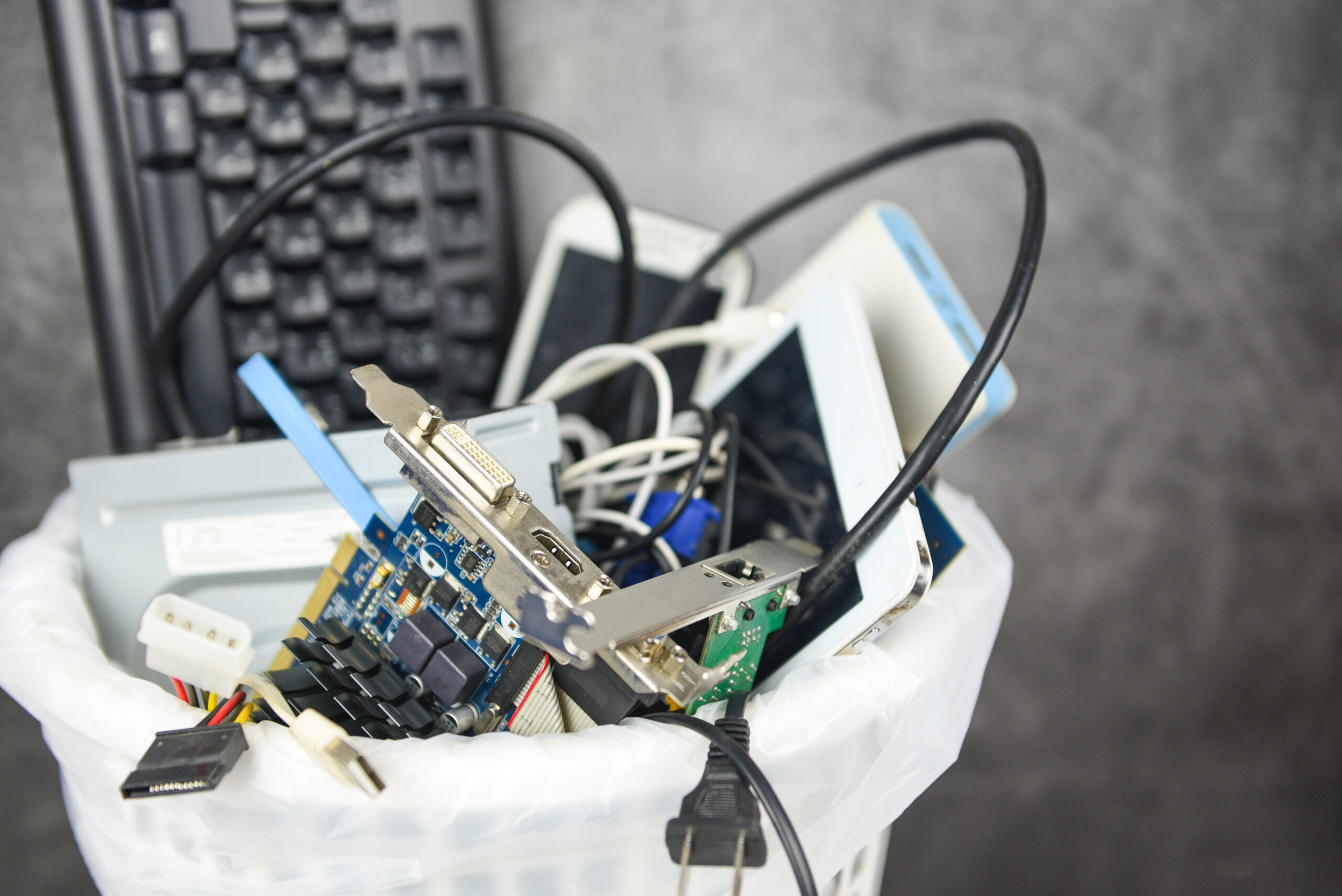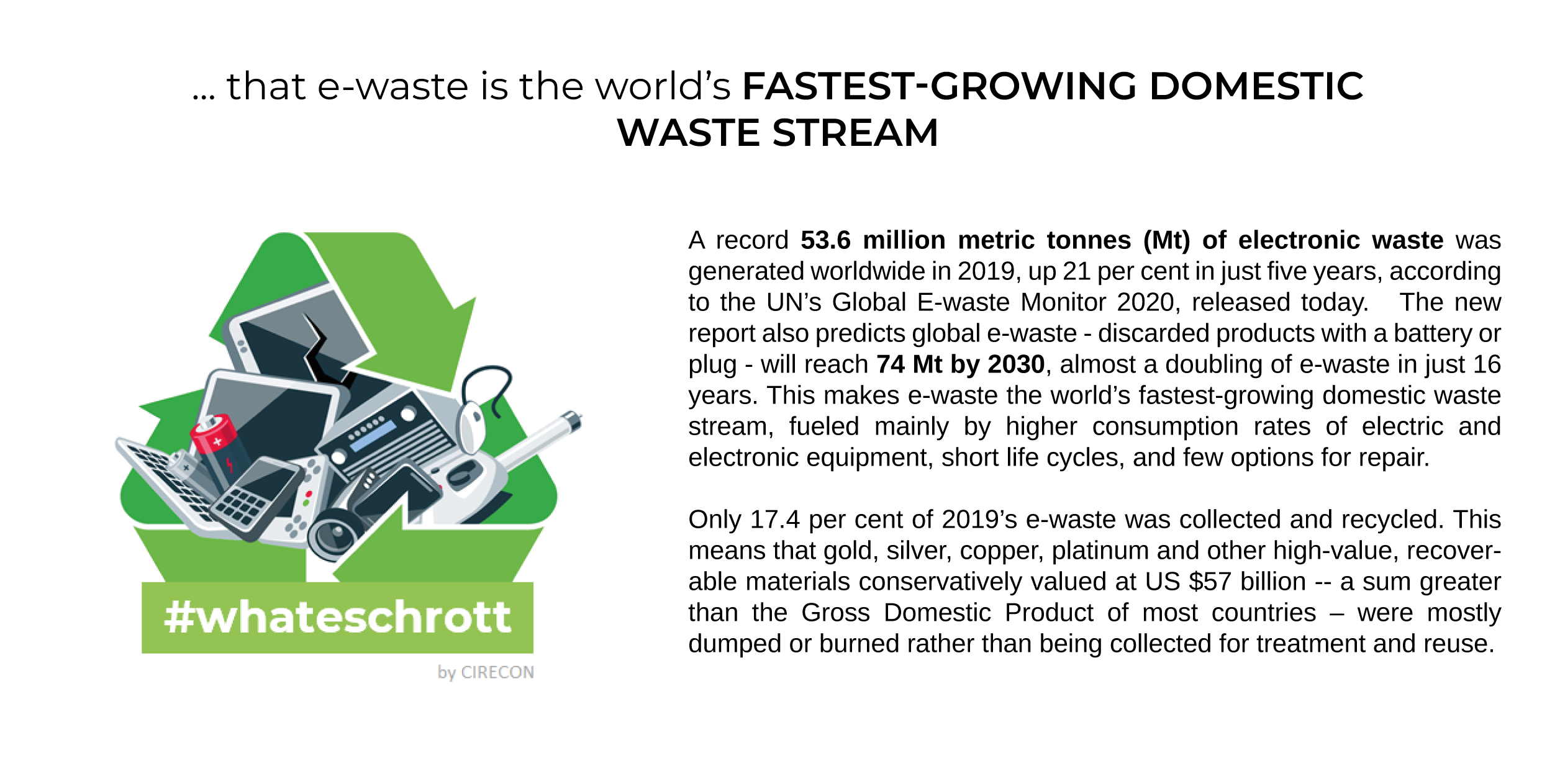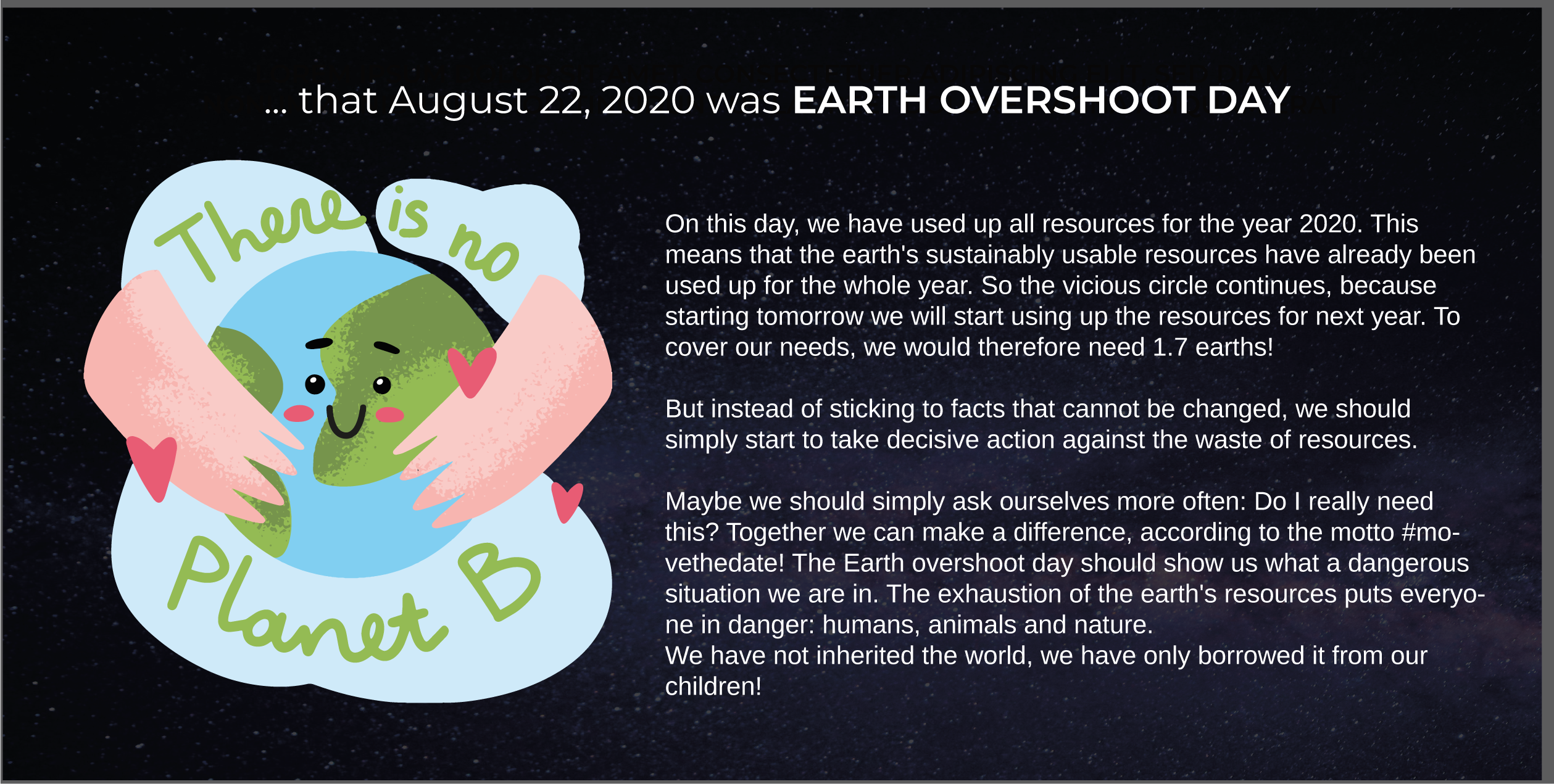We all know about a discarded stock of electronics at home: an old cell phone, MP3 player or three old remote controls, two worn-out batteries and a box of unused charging cables. In almost every household you can find old electrical appliances waiting to be disposed. There are many reasons for keeping discarded electronics, like planning to reuse it someday or keeping due to emotional commitment to such devices. Sometimes the reason is that people are simply not aware of the recycling options and may not know where to responsibly dispose of their e-waste.
E-waste – electronic waste – has become an essential part of everyday life and the way in which we produce, consume and dispose is unsustainable. On average, the total weight of global electronics consumption increases annually by 2.5 million metric tons with a result of 53.6 million tons of generated e-waste globally according to the Global E-Waste Monitor 2020. The growth of e-waste is obvious and for that reason CIRECON will show you how to leave a green footprint on our planet and protect the environment with small steps but great impact.
E–waste means electronic products nearing the end of their ‘useful life’. It includes any electrical and electronic equipment that’s been discarded. Computers, televisions, VCRs, stereos, copiers, and fax machines are common electronic products. Many of these products are still working and can be reused or refurbished. Broken items have to be recycled by certified recycling centers, therefore the correct collection is a high issue. The European Commission has divided e-waste into the following six categories.
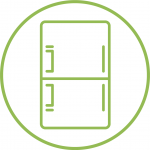
Temperature exchange equipment
Refrigerators, Freezers, Equipment which automatically deliver cold products, Air-conditioning equipment, Dehumidifying equipment,

Screens & monitors
Equipment containing screens having a surface greater than 100 cm² like Screens, Televisions, LCD photo frames, Monitors, Laptops, Notebooks,

Lamps
Straight fluorescent lamps, Compact fluorescent lamps, Fluorescent lamps, High intensity discharge lamps – including pressure sodium lamps and

Large equipment
Any external dimension more than 50 cm like Washing machines, Clothes dryers, Dish washing machines, Cookers, Electric stoves, Electric hot
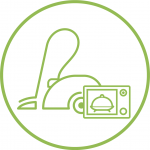
Small equipment
No external dimension more than 50 cm like Vacuum cleaners, Carpet sweepers, Appliances for sewing, Luminaires, Microwaves, Ventilation

Small IT and telecommunication equipment
No external dimension more than 50 cm like Mobile phones (smartphones, phablets etc.), GPS and navigation equipment, Pocket calculators, Routers,

Treasure or trash?
Advantages of recycling e-waste
Electrical appliances contain many toxic substances. If those get into the environment they are a danger for humans, animals, and plants. Unfortunately, the sad reality is that illegal waste disposal is a major issue, especially when it comes to electronic waste. The health of many inhabitants in countries with a bad e-waste management system is buried under the mountains of our old appliances. Electronic waste is hoarded, sorted with the bare hand and things that seem too worthless are simply burned. We can no longer ignore these facts.
E-waste is growing and with that surge comes the need for effective electronics recycling programs. According to a January 2020 report from the World Economic Forum, e-waste is now the fastest-growing waste stream in the world, with an estimated waste stream of 53.6 million tons in 2019. This is a growth of 9.2 Mt since 2014. It’s important to keep reinforcing that message. Throwing e-waste on landfills with bad recycling conditions causes less recycling rates of valuable raw materials and causes more harm than good.
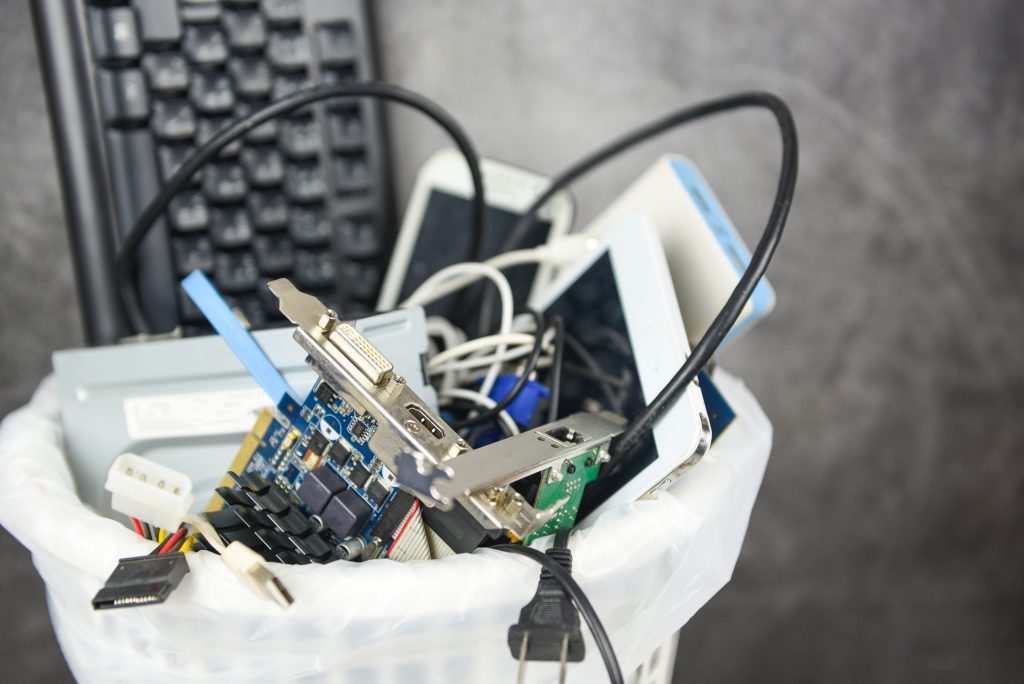
Gadget hoarding
A growing problem in the digital age
Do you have such a box with old cables, smartphones or your old game boy? Just because you might need that stuff again sometime? Maybe you will be a gadget hoarder, too! Gadget hoarding is a term for keeping unused electronics at home without using them anymore and it has become a widespread phenomenon, which is getting worse and worse due to digitalization. It needs to be clear, that these devices contain parts with the potential to make new products out of them and preserve natural resources through the recycling of secondary raw materials.
And why is gadget hoarding such a big problem for human health? First of all, you should always remember that an old electrical appliance is full of toxic substances that can pollute our environment. Old appliances that are incorrectly stored at home can also become a dangerous ticking time bomb. Please keep in mind that gadget hoarding of old electronics with a damaged lithium-ion-battery can be very dangerous due to a higher risk of fire and explosion! Due to this the disposal of electronics and batteries should always be separated.
The big question is: How to dispose the old electronic devices correctly?
Recycling centers, also known as public waste management authorities, are organized by the community in your town and one of the responsible collection points for e-waste. You can bring old electrical appliances there free of charge.
In Germany, dealers with a sales area for electronics larger than 400 square meters are obliged to take back old electrical appliances. You did not buy your appliance there? That does not matter! According to the German e-waste law, ElektroG, the dealer is obliged to take back each unit, smaller than 25 cm. Everyone can get rid of their old appliances there.
You are a dealer and fall under the e-waste take-back obligation? We can support you to comply with the law, improve your image and even make a profit with minimal effort.
Just contact us!
In case you buy new large appliances, e.g. washing machines, dryers and others, you are entitled to give your old unit to the dealer. Mostly, retailers offer on-site installation services for the new unit and take the old one to recycle it. The take-back option for the old unit has to be free of charge to the customer.
If you have purchased your electrical appliance online, the dealer has to ensure a return possibility for your old device, as soon as you want to get rid of after use. Here it is important that you have ordered it on this site. Only then the online dealer has the obligation to take it back. Check the website of your online shop to check the take-back option. In some cases collection sites are listed near your location or parcel services with a free of charge send-in label are offered.
If you are a company and want to get rid of a large amount of electronic waste, for example because you are completely re-equipping your office or because you have already hoarded a lot of electronic equipment in your stock, then get in touch with us. Via our CIRIS portal, B2B customers can arrange a pick-up request with one mouse-click. CIRECON will organize the collection of your old appliances directly from your office, warehouse, shop or wherever you want.
Attention! Batteries or rechargeable batteries in electrical appliances have to be removed and disposed of separately. Special battery collection systems offer boxes for the disposal, usually, the boxes are installed at the collection points for old devices.
The Earth’s resources are finite. In order to maintain our standard of living at the current level, it is becoming increasingly important to move from a linear economy to a circular economy. Many e-waste experts, including Craig Reucassel environmental champion from the ABC’s ‘War on Waste’, believe the biggest challenge to reducing e-waste is getting devices out of the drawers and garages and into recycling stations. Year after year the numbers of e-waste are skyrocketing.
Let us present you some tips how e-waste can be minimized.
Rent or borrow a device before you purchase
Before you purchase a new device and use it only once, think of several options you have. See if you can borrow the device from a friend or check out some websites where you can rent one. This will avoid that electronics are stored in one of your drawers after a one-off job and never used anymore.
![Minimize e waste planet b [Konvertiert] Minimize e waste planet b [Konvertiert]](https://cirecon.de/wp-content/uploads/2020/08/Minimize e waste planet b [Konvertiert]-350x350.png)
Donate your device to extend the life of your electronics
The idea of replacing working devices with new ones due to technical upgrades is a common behavior in our society. But there is no reason to throw the old unit away. Maybe there is someone in your circle of friends, who is still happy about it. You can also donate your device, especially IT-equipment like smartphones and notebooks, to a non-profit organization, which provides the unit to children, who usually don’t have easy access to such equipment. One man’s junk is another man’s treasure!
Sell your device to the second-hand market
To earn a bit of extra money, sell your unit to companies, which are collecting old devices, refurbishing, and reselling them. The units get a second life and can be bought at a cheaper price. So you make sure that every one of our society gets access to technical equipment and on the other side, this is a great way to reduce e-waste.
Think of repairing your broken device
If your electronic device is no longer working, you can try to repair the unit. Several online tutorials on the internet show you how to repair and exchange parts at home. In case you don’t want to repair your unit at home, you can visit a repair shop or repair cafés, where experts support you with your technical problem. Before starting to repair by yourself, check the warranty terms and conditions of your device to avoid loss of guarantee.


